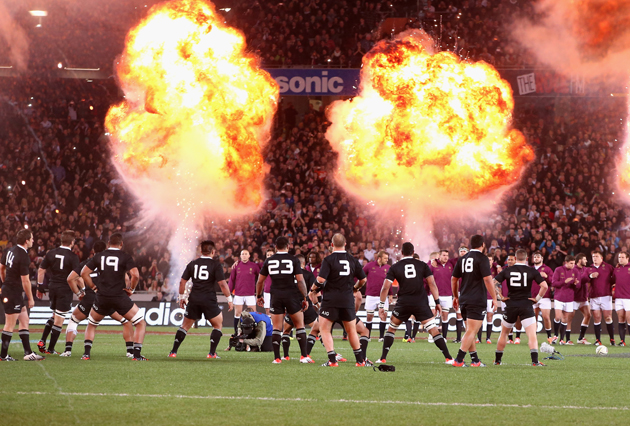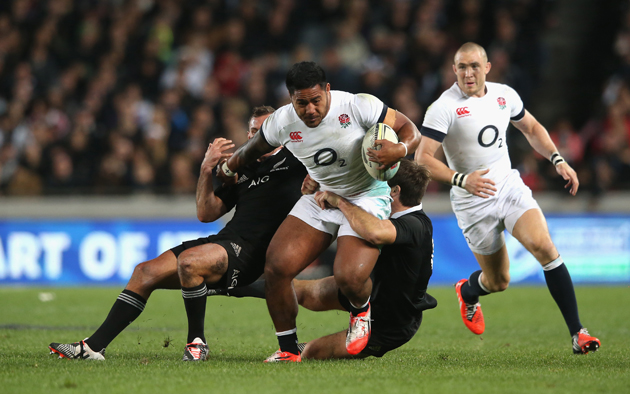After the narrow defeat in Auckland, what areas do England need to address ahead of the second Test against New Zealand in Dunedin?
STUART LANCASTER stressed last week that victory at Eden Park was very possible. Few believed him, most earmarking damage limitation as a more realistic goal.
But England’s coach wasn’t bidding to manufacture false confidence. His belief was rock-solid, and a supposedly understrength team backed up that conviction with an ambitious performance. Even so, it wasn’t enough to derail the world champions’ 32-match unbeaten run in Auckland. Conrad Smith’s last-gasp try snuck New Zealand into a 1-0 series lead.
Here are five things for England to heed following a superbly tense Test match…
The All Blacks won’t be that bad again
Realism is Lancaster’s currency, so he won’t sugar-coat any details of defeat. In fact, his first port of call will be to underline how poor New Zealand were. Just as during their first game of 2013 against France, the hosts seemed subdued.
At times, David Wilson and Joe Marler mangled their scrum. Collectively, the All Black back-line made elementary (almost Wilson-esque) handling errors. Ma’a Nonu was abject, Richie McCaw largely anonymous. Steve Hansen’s men benefited most from an iffy day at the office for referee Nigel Owens, too.
Though undercooked and maybe complacent, New Zealand still pulled through with a sense of grim inevitability. Liam Messam and Jerome Kaino provided awesome grit, Aaron Smith amazing guile. Many more will turn up on Saturday. Winning is a habit and the All Blacks are addicted – the really hard work starts now for Lancaster’s charges.
Familiar fine-tuning
Two lessons will lead England’s search for improvement this week. Both are subtle, yet frustratingly familiar. First, the tourists’ eventual downfall came from playing too much rugby inside their own half. Just before half-time and during the second period – most prominently while Marland Yarde was in the sin-bin – a failure to clear invited the All Blacks onto the front foot. They flooded the breakdown for three cheap penalties and, after kicking two and tapping one, gathered 11 points.
Those moments of suffocation were faintly reminiscent of what brought about England’s 30-3 defeat to Wales last March. Exit strategies – essentially the practice of getting back into opposition territory from set-piece or restart – are vital areas to iron out.
The second work-on is a continuing quibble from the recent Six Nations – turning opportunities into tries. Granted, things might have gone differently but for two cynical shirt-tugs from Nonu that definitely deserved yellow, but England made eight line breaks to New Zealand’s five. They beat more defenders (22 to 13) and executed twice as many offloads (eight to four). Such statistics need to translate into five-pointers.
Fantastic Fred backs up Billy
Now to start on the positives, beginning with a superb display from a fly-half who defied sofa doubters. Although he should take a modicum of blame for the above, Freddie Burns was magnificent on the whole – marrying a varied passing game with exceptional poise from the tee and underrated bravery in defence.
It was as if a dreadful season for Gloucester was nothing but a nightmare and this was his first outing since 2013’s assured trip to Argentina. Whatever went on behind the scenes at Kingsholm, it’s obvious Burns responds better to Lancaster than he did Nigel Davies.
The 24 year-old thrives on responsibility and was told to take it with George Ford injured. He reportedly bossed training for a fortnight and brought that same authority to Eden Park, reinforcing the permanence of class. After an eye-catching shift from little brother Billy in England U20’s defeat of Australia on Friday, Freddie came to the party as well. Besides any international prospects, Leicester Tigers fans should be elated. He could easily become a Welford Road legend.
Comeback kings
Question: Apart from being key figures in England’s admirable effort, what else do Rob Webber, Kyle Eastmond, Geoff Parling, Ben Youngs, Manu Tuilagi and James Haskell (as well as Burns) have in common? Answer: None of them had started a Test match for at least 12 months. Then there was Danny Cipriani, whose first two touches after a six-year international hiatus were a slicing half-break and a nerveless penalty.
Unfair as it is to single out individuals, Webber and Parling deserve special praise. The lineout was highlighted as a crucial platform and England’s axis delivered a 100% return from 13 throws, only one resulting in messy possession – brilliant accuracy and implementation of basic skills.
All this is of course testament to England’s strength in depth, but also a coaching team that can prepare a group of players for the rigours of Test rugby whatever the circumstances.
Happy headaches…but Manu’s not for moving
A further 16 players now become available to Lancaster from Saracens and Northampton. Danny Care and Billy Twelvetrees are fit for Dunedin too. But 41 into 23 doesn’t go. This is perhaps the most enticing selection debate for England in the professional era. Should Billy Vunipola replace the phenomenal Ben Morgan? Does Jonny May’s electric pace make up for uncertainty elsewhere?
The midfield is the most pain-staking piece of the jigsaw. Kyle Eastmond was excellent, but Twelvetrees brings a kicking game that would help the pack play in dangerous areas. Leaving out Luther Burrell is mighty brave.
Whoever Lancaster fills the 12 shirt with, Tuilagi will stay at outside-centre. Sir Clive Woodward’s suggestion to shift him onto the flank is a non-starter. Wing is the hardest place to play in England’s defensive system and, beating five defenders from 14 carries in Auckland, Tuilagi has a role from which he can influence and intimidate. If it ain’t broke…
Read all about Danny Care, Danny Cipriani and Israel Dagg in the latest edition of Rugby World – and you can find out where to buy your copy here. Download the digital edition here.








